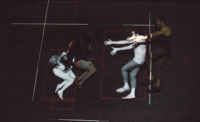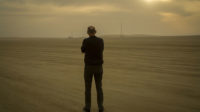Report card: Zaha Hadid's MAXXI turns out to be a good place to see art.
There's a giant, white, habitable sculpture sitting in the midst of Rome's nondescript Flaminio district just north of the city center. Its exterior juxtaposes sinuous curves and sharply angled planes, and its interior flows in smooth, serpentine capaciousness. It's Zaha Hadid's National Museum of XXI Century Arts (better known as MAXXI), and doubtless it's a work of art itself. But museums aren't supposed to be stand-alone masterpieces. They're supposed to display and enhance other works of art to visual and contextual advantage.
Museums that call too much attention to themselves can be a problem, or at least take some getting used to. After a half-century of use, Frank Lloyd Wright's Guggenheim Museum in New York (1959) has finally achieved an uneasy peace with the sculpture, paintings, and works of installation art that find their way onto its premises. On the other hand, Daniel Libeskind's Denver Art Museum (which opened in 2006) is still getting mixed reviews–to put it charitably–about the way art struggles to hold its own against the building's radically triangular structure. But two years after its opening, MAXXI is treating art rather well.
When Hadid entered the competition to design MAXXI, one of the ideas floated for its programming was to concentrate on Arte Povera, the abject style that was Italy's main contribution to post–World War II art. (The mind boggles a bit at the thought of such a sophisticated, glamorous edifice as a thematic home for art like Piero Manzoni's infamous 1961 can of Künstlerscheiss.) Fortunately, the museum's purpose was expanded to explicate contemporary art and architecture across the board. MAXXI is also Italy's only national museum dedicated to contemporary art–the others are regional or local–which gives it an advantage in prestige.
To make MAXXI accommodating to art, Hadid designed a set of contiguous indoor terraces that turn out to be a graceful solution to manifesting “separate” galleries in an emphatically open interior. The absence of disruptive walls gives art room to breathe, while the discrete and nicely shaped balcony-esque galleries allow relevant works of art to be gathered together in conversational closeness. Tridimensionale, an exhibition that ran from March to September, clearly benefited from these spaces. In the show, very dissimilar sculpture by Juan Muñoz (stylized bronze figures) and Franz West (faux-homely abstractions) enjoyed a kind of visual fellowship.
Moving among MAXXI's semi-separate staging areas is similarly amiable. Long, airy ramps, gently segmented stairways, and good lighting make traversing from one exhibition to another a pleasantly anticipatory experience. MAXXI does have a few white-cube spaces, and they work well, especially with one of the best photography exhibitions I've seen in years: To Face, Paola De Pietri's mesmerizing, large-format color images of World War I battlegrounds on the Italian front.
The most encouraging architectural aspect of MAXXI is its receptiveness to–indeed, crying out for–site-specific pieces that integrate themselves into the museum's own sculpture-like morphology. Finnish artist Kaarina Kaikkonen's installation this summer of children's garments hung on long, tapering rows of clotheslines–visible from both inside and outside the museum–humanized and softened the scale of the building. This is the institutional quality that prompted Carlos Basualdo, curator at the Philadelphia Museum of Art, to sign on as MAXXI's curator-at-large three years ago.“MAXXI is a building that, in many ways, dictates a program, and certainly calls for a close collaboration with living artists,” he says.
MAXXI does have problems, to be sure, but they have less to do with quality than quantity–the small amount of art it owns and the large sum of money it needs to keep going. It is hamstrung by having had to start a collection from scratch, mostly with government funds, in a country with a patchy history of private collectors donating art to public museums. Still, the roster of artists in MAXXI's holdings is impressive: Gerhard Richter, Kara Walker, Ed Ruscha, Rose Marie Troeckel, Anselm Kiefer, Mario Merz, Alighiero e Boetti, and younger artists such as Giorgio Andreotta Calò and Rosella Biscotti. The museum is collecting renowned artists but also taking some chances.
Alas, good things in the museum world don't come cheap. MAXXI requires about $12 million a year to operate, which it has tried to cobble together from ticket sales (attendance is just OK), profits from the bookshop and restaurant, corporate sponsors, and some private donations. There has been a lot of infighting between the Fondazione MAXXI, which runs the museum, and the national Ministry of Cultural Heritage. The ministry said MAXXI will incur a $13 million deficit between now and 2014, while the Fondazione's erstwhile president, Pio Baldi, claimed that the shortfall was illusory. Baldi resigned in May, and the museum was put into a “compulsory administration” (a.k.a. receivership) under a special commissioner. MAXXI is now scouring the country for new sponsors, and its officials say it will have some good news to announce.
Let's hope so. The museum itself is that rare work of art that's generous to other works of art. It would be a pity if MAXXI were to be substantially deprived of art or, worse, if contemporary art had no MAXXI to enjoy at all.
Newsweek














